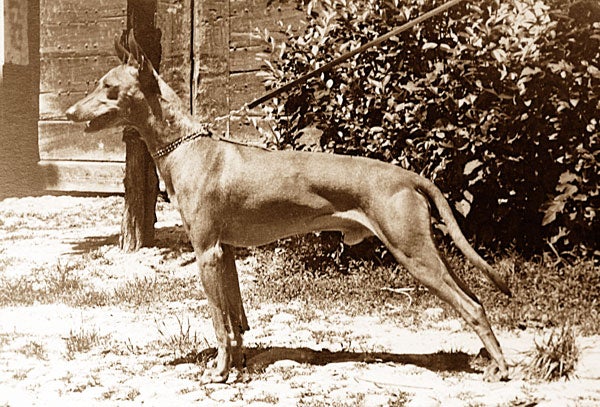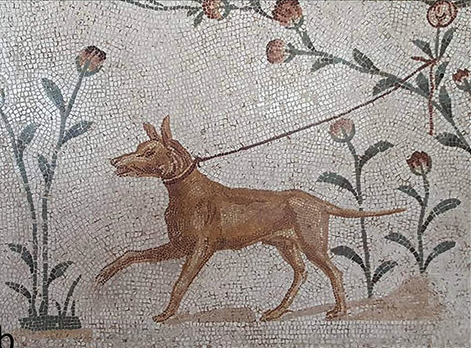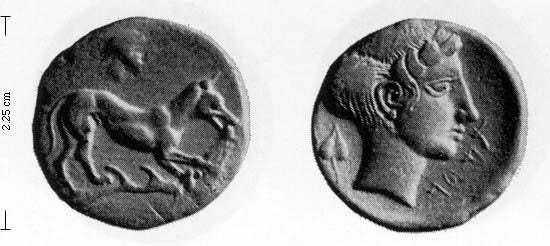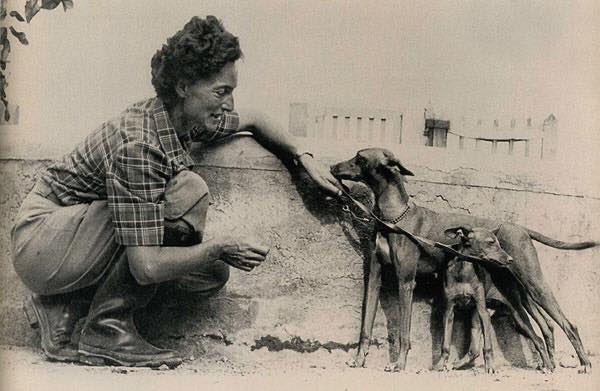
For millennia, the Cirneco dell’Etna has lived in the shadow of Mount Etna. Scrambling over the rocky, volcanic Sicilian soil in pursuit of rabbit, these small red dogs were invaluable sources of sustenance and protection for their peasant owners.
But by the time the 20th Century dawned, the Cirneco was facing its own sunset of sorts: So valuable were they in helping navigate rural life in the hardscrabble Sicilian countryside, the dogs were held impossibly close. Their owners refused to make puppies or even stud service available to outsiders, leading to concerns that this elegant but hardy breed might never be known outside its homeland.
Of course, the fact that you’re reading this article indicates that the Cirneco did manage, with its characteristic agility, to leap on to the international stage, thanks in large part to the efforts of one very unconventional Sicilian noblewoman.
But before meeting her, and understanding how she managed to introduce the Cirneco to the rest of Italy and, eventually, the world, we should get a handle on how to pronounce it.

Pronouncing Cirneco
Cirneco is sounded out like so: “cheer-NECK-oh.” If you want to appear in the know – especially around Cirneco fanciers, whose connection to their breed’s Italian homeland is still as strong as a double espresso – refer to the plural as “Cirnechi” (“cheer-NECK-key”) instead of the clumsy, Americanized “Cirnecos.”
So that’s one Cirneco, two Cirnechi.
No matter what the number, the word “cirneco” derives from the ancient Roman colony of Cyrena in North Africa, located in what is now Libya. It’s believed the dogs from this area – described by Aristotle as the result of canine crosses to Ethiopian wolves – arrived in Sicily on the boats of Phoenician traders. While those ancient roots are impossible to prove, what is clear is that the Cirneco is the oldest of all the recognized Italian breeds, having hunted on its isolated Sicilian island long before Neapolitan Mastiffs guarded the cobblestoned courtyards of Naples or Italian Greyhounds nestled on pillows in the palazzi of Florence. One legend holds that a thousand Cirneco once guarded the temple of the local fire god Adranos, which was located, logically, on the slopes of Mount Etna.
The Cirneco vs. Other Sighthounds
In Italian, “cirneco” with a small “C” is used to describe all the lithe, prick-eared hunting dogs developed on Mediterranean islands, including Malta and the Balearics, which brought us the Pharaoh Hound and Ibizan Hound, respectively. Some genetic studies have shown the Cirneco to be genetically related to these two breeds, which use their noses and ears as much as their eyes to locate prey. More recent research has confirmed the Pharaoh Hound as a close relative, as well as the Segugio Italiano. Not yet recognized by the American Kennel Club, the Segugio is sort of Italy’s answer to our Coonhounds, with hanging, low-set ears, and a history that purportedly traces back to ancient Egypt. It’s quite plausible that the Segugio and Cirneco share a long-ago African ancestor brought to Sicily by those not-content-to-stay-put Phoenician traders.
To the uninitiated, the Cirneco might appear to be a miniaturized Pharaoh Hound, but the two breeds are differentiated by more than just size: The Pharaoh Hound is slightly longer than tall, while the Cirneco is square. And while both breeds have large ears – all the better to hear you with, my dear rabbit – those of the Cirneco are higher set and parallel when alert, while the Pharaoh Hound’s are much more mobile. The Cirneco can also have white anywhere on its body, while the Pharaoh has a disqualification for any white on the back, shoulder or sides of the dog, as well as the back of the neck.

Donna Agata & The Cirneco
The Cirneco might have slipped silently into oblivion were it not for a 1932 newspaper article in an Italian hunting magazine by veterinarian Maurizio Migneco, who was alarmed by the decline of the breed.
Enter baroness Agata Paterno Castello, whose family had held the dukedom in Carcaci since the early 1700s.
At only 18 years old, Donna Agata – literally, Lady Agatha – had a persistent habit of shattering cultural norms: Even in sternly conservative Sicily, she wore pants in public, attended university, went abroad to hunt, and was an irrepressible entrepreneur. Not surprisingly, she was also single-mindedly tenacious: After deciding to raise hornless Maltese goats, Donna Agata discovered that some nonetheless sprouted horns; unperturbed, she picked up a hacksaw and removed them herself.
Despite the goat-trimming incident, Donna Agata was an unapologetic animal lover, bringing dozens of dogs home during World War II to protect them during air raids, and even playing bridge in the living room in the company of a calf. After seeing a female Cirneco named Fettuccia owned by one of her employees, Donna Agata was smitten. While the breed was undeniably rustic – a common “haystack dog” compared to the imported setters and pointers that had become such status symbols – Donna Agata saw in the Cirneco an inherent nobility that she doubtless felt paralleled her own.
Inspired by Migneco’s article, in which he exhorted fanciers to help save this Sicilian breed from certain extinction, Donna Agata set out to do just that. But rather than acquiescing to this woman of such high station, Sicily’s peasants doubled down, refusing to relinquish to her the valuable dogs that their ancestors had bred for untold generations. While perhaps short-sighted, it was an understandable reaction: The Cirneco was of the few inheritances these poor but proud hunters could claim.

A Rare but Coveted Breed
Undaunted, Donna Agata continued to scour Sicily for excellent examples of the breed to stock her fledgling Aetnensis kennel, its name a Latin reference to Mount Etna. (Though the breed is named for that famous volcano, and existed in great numbers in its vicinity, it was found throughout Sicily.) Even if she could not acquire a particular dog herself, seeing as many as possible helped Donna Agata understand the nuances that helped define the breed. When she was confident of her observations, she turned to noted dog expert Giuseppe Solaro, who wrote the standard without ever stepping foot in Sicily. In short order, in 1939, the breed was recognized by the Italian kennel club.
While Donna Agata bred the first two champions in the breed – Aetnensis Pupa and Aetnensis Edo – she did not have the opportunity to see the breed come to full flower: Donna Agata died tragically of cancer in 1958, at only 44 years old.
Despite Donna Agata’s dedication, the Cirneco dell’Etna is still very much a rare breed, albeit a coveted one: In the 1970s, the cost of a puppy was almost a third of an average worker’s monthly salary. By the early 2010s, Italian breeders were only registering 100 to 150 puppies a year.
The Cirneco first arrived in the United States in 1996, and it wasn’t until almost two decades later, in 2015, that the American Kennel Club formally recognized the breed. But the Cirneco, known for its hardiness, is nothing if not a survivor. Just as its image graced ancient coins and pottery that date back for millennia, there’s every reason to believe the Cirneco will continue to endure, tended like a flickering flame by those who are captivated by this elegant hunting dog and its ancient beginnings.

